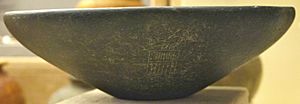First Dynasty of Egypt facts for kids
The First Dynasty was the first group of kings who ruled over a united ancient Egypt. This important time started when Upper Egypt and Lower Egypt became one country. Many historians believe Narmer was the king who brought them together. This period is also known as the beginning of the Early Dynastic Period. The city of Thinis was the main center of power during this time.
Historians are not completely sure about the exact dates for the First Dynasty. It was part of the Bronze Age, a time when people started using bronze tools. Experts use different methods to figure out when events happened in ancient Egypt. The First Dynasty likely began sometime between 3400 and 3000 BC. In 2013, a method called radiocarbon dating suggested that King Hor-Aha started his rule between 3218 and 3035 BC.
Contents
Who Were the First Dynasty Kings?
The First Dynasty had several important rulers. These kings helped shape the early history of united Egypt. Here are some of the known pharaohs from this period:
- Narmer (or Menes): Most experts think Narmer and Menes were the same person. He is often credited with uniting Upper and Lower Egypt.
- Hor-Aha: He was an early king of the First Dynasty.
- Djer: He ruled for many years, around 41 years.
- Djet: Another important king of this dynasty.
- Merneith: She was a queen and the mother of King Den. She may have ruled for a time.
- Den: He was a powerful pharaoh who ruled for a long time.
- Anedjib: He followed Den as king.
- Semerkhet: He was one of the later kings of the dynasty.
- Qa'a: He was the last known king of the First Dynasty.
How Do We Know About the First Dynasty?
Most of what we know about the First Dynasty comes from ancient objects. These objects have the names of the kings carved on them. Some of the most important finds include:
- The Narmer Palette: This is a famous stone tablet showing King Narmer. It might show him uniting Egypt.
- The Narmer Macehead: This is another object linked to King Narmer.
- King Lists: Some lists, like those from the tombs of Den and Qa'a, help us know the order of kings.
We don't have many detailed stories from this time. The Palermo Stone gives only brief notes. An ancient writer named Manetho wrote a book about Egyptian history. However, his list of First Dynasty rulers doesn't quite match what archaeologists have found.
During this dynasty, hieroglyphs (the ancient Egyptian writing system) were fully developed. These symbols would be used for over 3,000 years with very few changes.
Life and Inventions in the First Dynasty
Archaeologists have found large tombs for the pharaohs at places like Abydos and Naqada. There are also cemeteries near Memphis at Saqqara and Helwan.
The buildings from this time were mostly made of wood and mud bricks. Stone was used for some walls and floors, but it was more common for making beautiful ornaments, containers, and statues.
The people of the First Dynasty were skilled builders. They used a type of tree called Tamarix (tamarisk) to build boats. These boats, like the famous Abydos Boats, were very important for travel and trade.
They also invented a clever way to join pieces of wood together. This was called the fixed mortise and tenon joint. It involved shaping the end of one piece of wood (the tenon) to fit perfectly into a hole (the mortise) cut into another piece. A different version of this joint, using a separate tenon, became very important in shipbuilding across the Mediterranean and Egypt.
Burial Practices and Human Sacrifice
During the First Dynasty, a practice called human sacrifice was part of the pharaohs' burials. This meant that servants and animals were buried near the pharaoh's tomb. For example, 338 people were buried near the tomb of King Djer. It was believed that these people and animals, like donkeys, would help the pharaoh in the afterlife.
For reasons we don't fully understand, this practice stopped after the First Dynasty. In later periods, small figures called shabtis were used instead of real people. These shabtis were like little dolls that were supposed to do work for the pharaoh in the afterlife.
| Preceded by New creation |
Dynasty of Egypt c. 3100 – 2890 BC |
Succeeded by Second dynasty |
Images for kids
-
The Narmer Palette
-
Necklaces with different types of beads. Carnelian, coral, and garnet.
See also
 In Spanish: Dinastía I de Egipto para niños
In Spanish: Dinastía I de Egipto para niños






